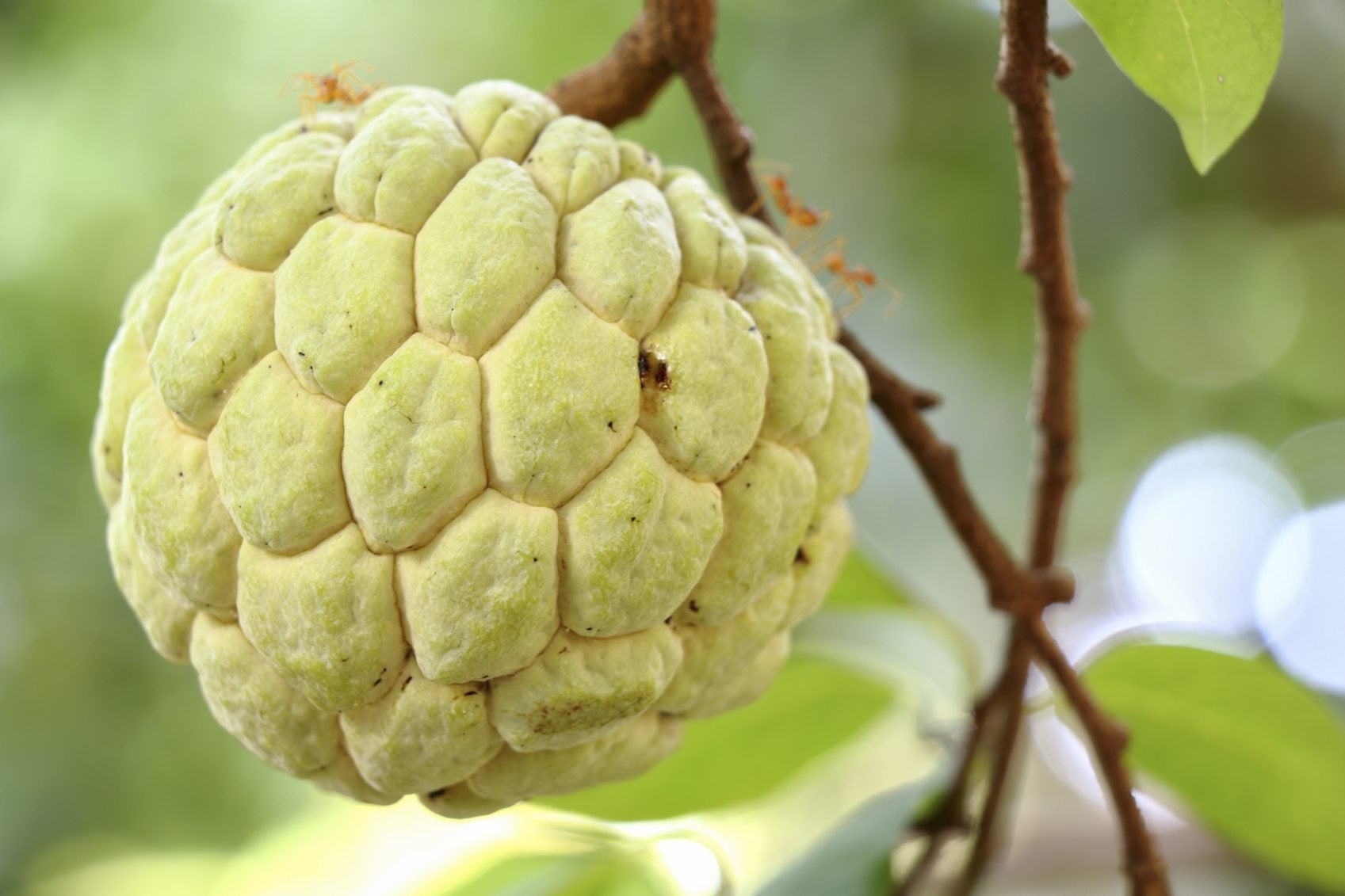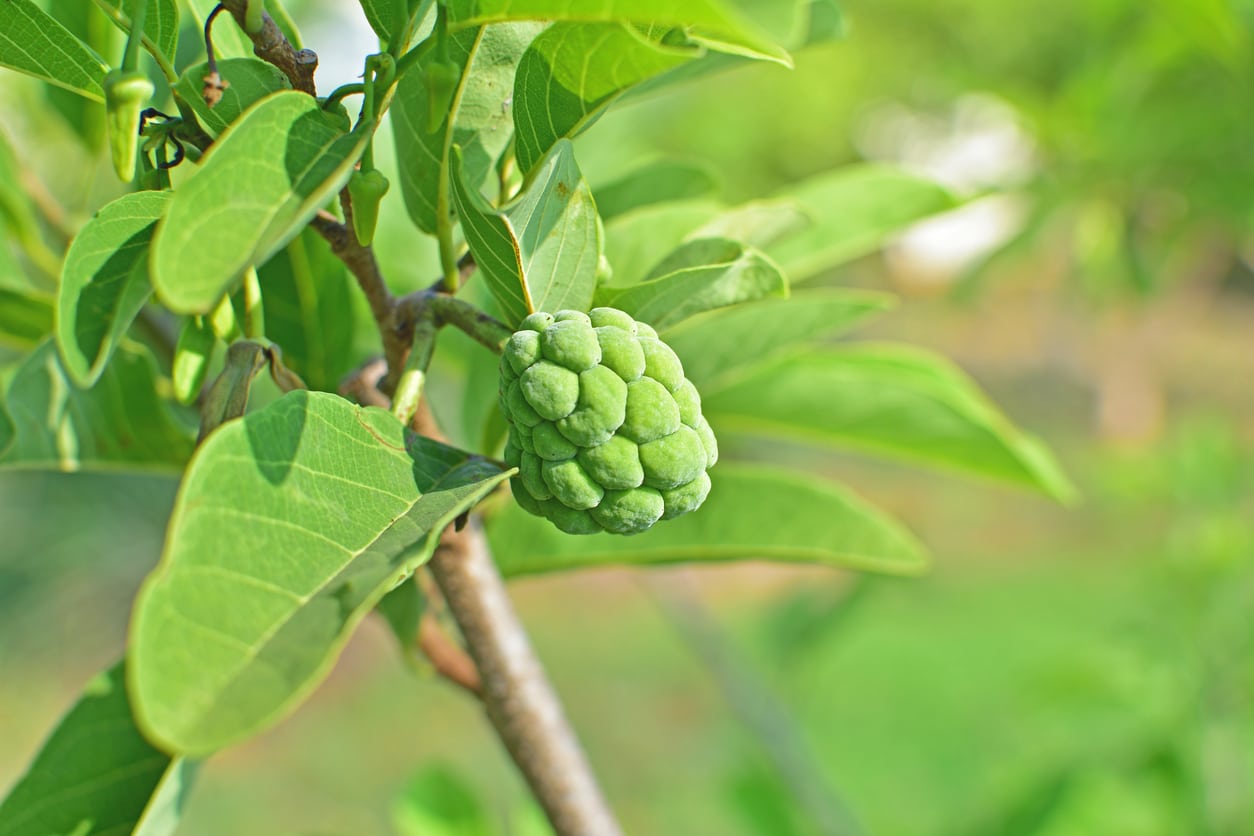What Is Sugar Apple Fruit: Can You Grow Sugar Apples

Ovoid to nearly heart-shaped, covered in knobby gray/blue/green hues that look almost like scales on the outside and inside, sections of glistening, creamy-white flesh with a shockingly pleasant aroma. What are we talking about? Sugar apples. What exactly is sugar apple fruit and can you grow sugar apples in the garden? Read on to find out about growing sugar apple trees, sugar apple uses, and other information.
What is Sugar Apple Fruit?
Sugar apples (Annona squamosa) are the fruit of one of the most commonly grown Annona trees. Depending upon where you find them, they go by a plethora of names, amongst them include sweetsop, custard apple, and the apropos scaly custard apple. The sugar apple tree varies in height from 10-20 feet (3-6 m.) with an open habit of irregular, zigzagging twigs. Foliage is alternate, dull green on top and pale green on the underside. Crushed leaves have an aromatic scent, as do the fragrant flowers which may be single or in clusters of 2-4. They are yellow-green with a pale yellow interior borne off of long drooping stalks. The fruit of sugar apple trees is about 2 ½ to 4 inches (6.5-10 cm.) long. Each fruit segment typically contains a ½-inch (1.5 cm.) long, black to dark brown seed, of which there may be up to 40 per sugar apple. Most sugar apples have green skins, but a dark red variety is attaining some popularity. Fruit ripens 3-4 months after flowering in the spring.
Sugar Apple Information
No one is exactly sure where sugar apples hail from, but they are commonly cultivated in tropical South America, southern Mexico, the West Indies, Bahamas, and Bermuda. Cultivation is most extensive in India and is wildly popular in the interior of Brazil. It can be found growing wild in Jamaica, Puerto Rico, Barbados, and in the drier regions of North Queensland, Australia. It’s likely that Spanish explorers brought seeds from the New World to the Philippines, while the Portuguese are thought to have brought the seeds to southern India prior to 1590. In Florida, a “seedless” variety, ‘Seedless Cuban,’ was introduced for cultivation in 1955. It does have vestigial seeds and has a less developed flavor than other cultivars, grown primarily as a novelty.
Sugar Apple Uses
The fruit of the sugar apple tree is eaten out of hand, separating the fleshy segments from the outer peel and spitting the seeds out. In some countries, the pulp is pressed to eliminate the seeds and then added to ice cream or combined with milk for a refreshing beverage. Sugar apples are never used cooked. The seeds of the sugar apple are poisonous, as are the leaves and bark. In fact, powdered seeds or dried fruit have been used as a fish poison and insecticide in India. A seed paste has also been used pasted on the scalp to rid people of lice. The oil derived from the seeds has also been used as a pesticide. Conversely, the oil from sugar apple leaves has a history of use in perfumes. In India, the crushed leaves are snorted to treat hysteria and fainting spells and topically applied to wounds. A leaf decoction is used throughout tropical America to treat a multitude of symptoms, as is the fruit.
Can You Grow Sugar Apple Trees?
Sugar apples need a tropical to near-tropical climate (73-94 degrees F. or 22-34 C.) and are unsuited to most areas of the United States with the exception of some areas of Florida, although they are cold tolerant to 27 degrees F. (-2 C.). They thrive in dry areas except during pollination where high atmospheric humidity seems to be an important factor. So can you grow a sugar apple tree? If you are within that climactic range, then yes. Also, sugar apple trees do well in containers in greenhouses. The trees do well in a variety of soils, provided they have good drainage. When growing sugar apple trees, propagation is generally from seeds that may take 30 days or longer to germinate. To hasten germination, scarify the seeds or soak them for 3 days prior to planting. If you live in a tropical zone and wish to plant your sugar apples in the soil, plant them in full sun and 15-20 feet (4.5-6 m.) away from other trees or buildings. Feed young trees every 4-6 weeks during the growing season with a complete fertilizer. Apply a 2- to 4-inch (5-10 cm.) layer of mulch around the tree to within 6 inches (15 cm.) of the trunk to retain moisture and regulate soil temperature.
Gardening tips, videos, info and more delivered right to your inbox!
Sign up for the Gardening Know How newsletter today and receive a free copy of our e-book "How to Grow Delicious Tomatoes".

Amy Grant has been gardening for 30 years and writing for 15. A professional chef and caterer, Amy's area of expertise is culinary gardening.
-
 Try The Trend – Turn Any Bed Into A Keyhole Garden With This Clever In-Ground Composter
Try The Trend – Turn Any Bed Into A Keyhole Garden With This Clever In-Ground ComposterKeyhole gardening is an efficient and sustainable practice that saves space. Get started on this DIY project quickly and easily with an in-ground composter.
By Bonnie L. Grant
-
 4 Superfast Composting Methods: Turn Waste Into Garden Gold In 30 Days Or Less
4 Superfast Composting Methods: Turn Waste Into Garden Gold In 30 Days Or LessTry the fastest composting methods to turbocharge your pile and transform kitchen scraps and garden waste into finished compost in just a few weeks.
By Mary Ellen Ellis
